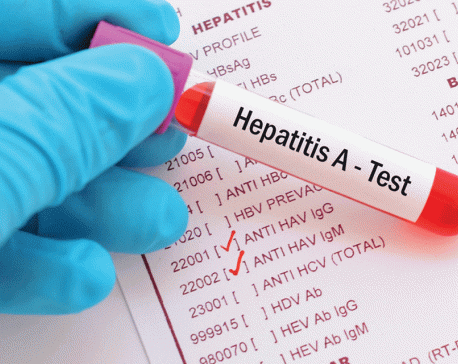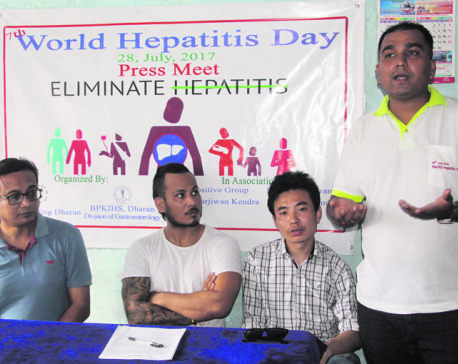
OR
World Hepatitis Day 2021


Dr Pallavi Koirala
The author is a junior resident at College of Medical Sciences, Bharatpurkoiralapallu@gmail.com
Every year, World Hepatitis Day is celebrated on July 28 to raise awareness and understanding of the disease. This date remarks the birthday of Nobel prize-winning scientist Dr Baruch Bloomberg who discovered the hepatitis virus and developed the diagnostic test and vaccine against the virus.
A few years ago while working as a medical officer in the Medicine ward of Civil Service Hospital in Nepal, I was looking after a patient with hepatitis. My memory of him still lingers on years after. It was one of the hardest moments I had to face as a doctor. The chronicity of the disease unfortunately took his life. He was suffering from Hepatitis C and his liver was damaged by both virus and excessive consumption of alcohol. His family members were well aware of the prognosis of his disease. However, declaring the death of a patient to their family members never gets easy and especially not when the person is the sole breadwinner of the family with two little kids.
Don McPherson, the famous football player once said, “True prevention is not waiting for bad things to happen; it’s preventing things from happening in the first place.” Raising awareness about any disease is the first and the most important step in controlling the spread of the disease.
Hepatitis is the inflammation of the liver which when not treated on time can lead to death. It can be both acute (short-term) and chronic (long-term) infection. The type of hepatitis viruses are Hepatitis A, B, C, D, and E. Alcoholic hepatitis can be caused by excessive consumption of alcohol. Hepatitis C is the major cause of liver cancer.
Hepatitis A and E usually spread through food and water that is contaminated with the infected fecal material. Hepatitis B, C, and D spread through contact with the infected blood or fluids through shared needles or unprotected sex, invasive medical procedures with contaminated equipment, transfusion of unscreened blood, and from mother to baby while giving birth. A person infected with HBV and HCV may not develop symptoms for years. However, hidden inflammation may be progressive and may develop end-stage chronic liver diseases such as cirrhosis and hepatocellular carcinoma.
Most of the HAV and HEV cases are self-limiting whereas 70-80% of people infected with HBV and HCV progress to chronic hepatitis. Type B and C lead to chronic disease in hundreds of millions of people and together are responsible for liver cirrhosis, cancer (hepatocellular carcinoma), and viral hepatitis-related deaths. These long-term complications account for 96% of deaths due to viral hepatitis.
Globally, 325 million people live with hepatitis infection. Hepatitis B and C are the most common causes of death with 1.3 million lives lost each year. Most HBV infections are more common before five years of age. Therefore, HBV prevention focuses on children under five years of age through vaccination. The effectiveness of the Hepatitis B vaccine has dramatically decreased the death rates across the globe. Nepal along with countries like Bangladesh, Bhutan, and Thailand have been among the first countries in WHO southeast Asian Region to achieve Hepatitis B control with the prevalence of less than one percent of cases among children below five years of age.
“Global Health Sector Strategy on Viral Hepatitis 2016-2021” was adopted by the World Health Assembly which has a target to reduce new hepatitis infections by 90%, reduce deaths due to viral hepatitis by 65%, and treat 80% of people living with the infections by 2030. The targets can only be achieved by implementing five synergistic prevention and treatment interventions. These are (1) Immunization against Hepatitis B, (2) Prevention of mother-child transmission of HBV, (3) Blood and injection safety (4) Prevention and transmission of HBV and HCV among persons who inject drugs through comprehensive harm reduction services, and (5) Testing and treatment.
The development of molecular techniques, the miraculous discovery of vaccines, and effective antiviral medications have a huge role in controlling the spread of this disease. Antiviral medications can cure more than 95 % of people suffering from HCV, thereby reducing the risk of death from liver cirrhosis and hepatocellular carcinoma. However, to reach the elimination phase, evolving the understanding of the virus through community participation, raising awareness about the risk factors and then chronicity of the disease is imminent.
Research shows that the stigma and discrimination of hepatitis are primarily related to a poor understanding of the disease and its prevention. So, proper counseling of the patient and the family members about the disease and raising public awareness about the transmission will help in reducing the stigmatization of the disease.
Every year, World Hepatitis Day is celebrated on July 28 to raise awareness and understanding of the disease. This date remarks the birthday of Nobel prize-winning scientist Dr Baruch Bloomberg who discovered the hepatitis virus and developed the diagnostic test and vaccine against the virus. With the theme “Hepatitis can’t wait”, this year this day will be celebrated trying to convey the urgency of efforts needed to eliminate hepatitis as a public health threat by 2030.
The road to elimination by 2030 requires a comprehensive public health approach taken to scale. Service coverage of laboratory testing and treatment should be scaled up. The high-risk group should be focused and a strategic approach should be implemented. Expanding the vaccination for HAV and HBV to the wider range and availability of affordable laboratory investigations and antiviral medicines for this disease should be focused on. Hence with the collaborative efforts from both public and private sectors, the elimination of Hepatitis B is not so far.
(The author is a Junior Resident at the College of Medical Sciences, Bharatpur.)
You May Like This

What we need to know about hepatitis
Viral hepatitis is currently killing an estimated 410,000 in our region annually—more than HIV and malaria combined. ... Read More...

Hepatitis C spreading its tentacles unnoticed
DHARAN, July 29: Stating that hepatitis C is a fast-spreading 'viral time bomb' which needs serious intervention, health specialists and... Read More...

Viral load test for Hepatitis B now in Nepal
KATHMANDU, July 13: The viral load test for Hepatitis B could be done in Nepal now on. The test is... Read More...







Just In
- NRB to provide collateral-free loans to foreign employment seekers
- NEB to publish Grade 12 results next week
- Body handover begins; Relatives remain dissatisfied with insurance, compensation amount
- NC defers its plan to join Koshi govt
- NRB to review microfinance loan interest rate
- 134 dead in floods and landslides since onset of monsoon this year
- Mahakali Irrigation Project sees only 22 percent physical progress in 18 years
- Singapore now holds world's most powerful passport; Nepal stays at 98th











Leave A Comment